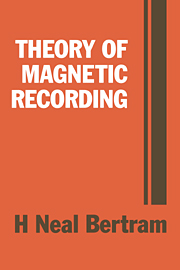Book contents
- Frontmatter
- Contents
- Preface
- 1 Overview
- 2 Review of magnetostatic fields
- 3 Inductive head fields
- 4 Medium magnetic fields
- 5 Playback process: Part 1 – General concepts and single transitions
- 6 Playback process: Part 2 – Multiple transitions
- 7 Magnetoresistive heads
- 8 Record process: Part 1 – Transition models
- 9 Record process: Part 2 – Non-linearities and overwrite
- 10 Medium noise mechanisms: Part 1 – General concepts, modulation noise
- 11 Medium noise mechanisms: Part 2 – Particulate noise
- 12 Medium noise mechanisms: Part 3 – Transition noise
- References and bibliography
- Index
12 - Medium noise mechanisms: Part 3 – Transition noise
Published online by Cambridge University Press: 02 February 2010
- Frontmatter
- Contents
- Preface
- 1 Overview
- 2 Review of magnetostatic fields
- 3 Inductive head fields
- 4 Medium magnetic fields
- 5 Playback process: Part 1 – General concepts and single transitions
- 6 Playback process: Part 2 – Multiple transitions
- 7 Magnetoresistive heads
- 8 Record process: Part 1 – Transition models
- 9 Record process: Part 2 – Non-linearities and overwrite
- 10 Medium noise mechanisms: Part 1 – General concepts, modulation noise
- 11 Medium noise mechanisms: Part 2 – Particulate noise
- 12 Medium noise mechanisms: Part 3 – Transition noise
- References and bibliography
- Index
Summary
Introduction
This chapter will address noise arising from fluctuations localized at the transition. Transition noise is dominant in metallic thin films where the average magnetization lies in the longitudinal or recording direction (Bertram, et al., 1992). Transition noise can also occur in perpendicular film media. These media are prepared either by sputtering or by plating processes and are extremely uniform so that conventional sources of amplitude modulation noise, as discussed in Chapter 10, are not present. The fundamental feature of thin films that gives rise to transition noise is the almost completely dense packing of these polycrystalline media (Fig. 1.2). With dense packing the medium noise depends strongly on the state of magnetization.
In Figs. 12.1 (a), (b) illustrations of the magnetization configurations for grains with solely longitudinal orientation are shown for a saturated medium (a) and an erased medium (b). For the saturated case the ‘poles’ at the ends on one grain cancel those of each adjacent grain. In this case no noise voltage will occur. In the erased case the average magnetization vanishes. To achieve this state, adjacent grains with opposite magnetization will occur, giving rise to localized ‘poles’ at the grain interface of twice the magnitude of that of individual grains. Even with magnetization correlation, a random distribution of these ‘double’ poles will occur, of both polarities, leading to a replay noise voltage. In general, noise voltage sources will occur for all configurations where the medium is not saturated. The greatest number of noise sources will occur for states where the average magnetization vanishes. Media uniformly magnetized at various states along the major loop will exhibit fluctuations that maximize at the remanent coercive state.
- Type
- Chapter
- Information
- Theory of Magnetic Recording , pp. 306 - 336Publisher: Cambridge University PressPrint publication year: 1994
- 3
- Cited by



